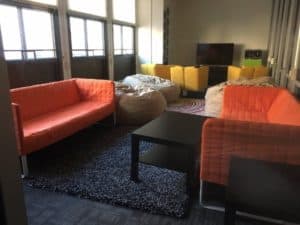American University Students and Staff Call for Minority-Only ‘Spaces’ on Campus to Promote Inclusion
Emily Lytle, The Eagle, December 10, 2018
The Hub for Organizing, Multiculturalism and Equity, or HOME, is now open to students. It is located in MGC 331A.
As AU carries out its diversity and inclusion strategy and takes a closer look at improving the University’s campus climate, students and administrators have pushed for the creation of more spaces for students of color.
One of the spaces born out of those conversations was the Hub for Organizing Multiculturalism and Equity, or HOME. The space is located on the third floor of the Mary Graydon Center and aims to be a space where students of different identities “can just come and be,” said Fanta Aw, the vice president of campus life and inclusive excellence.

Hub for Organizing, Multiculturalism and Equity, or HOME, where there’s “no sense of security” and “no sense of belonging,” because it’s open to whites.
But while some students and administrators praise HOME for fostering a sense of community and belonging among students of color, other students say the room falls short of what they think a space for students of color should be. Their complaints range from the small size of the space to how HOME has been marketed to students of all backgrounds rather than to students of color.
“HOME doesn’t provide people with a sense of security, with a sense of belonging, when everyone from all types of affinity groups can be there,” said senior Othniel Malcolm Andrew Harris, who has been involved in organizing protests at AU.
{snip}
Prior to the opening of HOME, there was not a space for students of color to build community, said Ayana Wilson, AU’s student activities director.
“There were no spaces where students of color felt safe,” Wilson said.
{snip}
However, some students say that the purpose of the room is lost by making the space open to all students.
{snip}
Several students reported positive experiences at HOME. Danielle Vinales, a senior political science major, said that she often brings underclassmen to the space to “study and chill.” She spends a lot of her free time there, she said.
“Communities [have] to learn how to work together and how to hang out together, and HOME was that,” Vinales said.
{snip}
Black students continue to call for black house, living-learning community
Following racist incidents and a hate crime targeting black students at AU in 2017, many students in the black community pressed the University to create a black house or black space on campus.
“What we needed was a large community space that the entire black community could get together and support one another,” said Ma’at Sargeant, a senior who has been an organizer of several student protests at AU.
After then-Student Government President Taylor Dumpson helped to launch HOME last fall, several students said they viewed HOME as a response to their request for a black house.
{snip}
While the idea of what a black house would look like at AU varied among students who spoke to The Eagle, many students and administrators have pointed to Georgetown University’s Black House as a model.
Black House, along with Casa Latina, are physical houses and living learning communities where residents participate in an application process and interview to be selected, according to Vanice Antrum, the program coordinator for the Center for Multicultural Equity & Access at Georgetown University.
“The houses contribute to the student experience by creating a space dedicated to creating a welcoming environment to students of color on campus,” Antrum said in an email.
{snip}
In building a black house and living-learning community, Aw said that it’s important to assess whether other affinity groups may be interested, and whether the University can also respond to that interest.
“Because we go to AU, if we give space to one minority group, every single other minority group is going to be marching outside of MGC,” Cestero said.
{snip}
But some students said that they seek a space where they can be with people of their same identity. Harris said he’d like to see a black space that puts on events about the history of black students at American University.
{snip}















